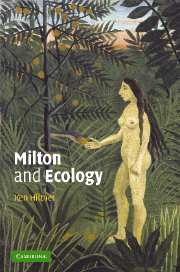Book contents
- Frontmatter
- Contents
- Acknowledgments
- Preface
- Introduction
- PART I HAVING PLACE
- PART II THE UNDERLYING IMPORTANCE OF PLACE
- 5 The New Testament's call to place: Paul's and Luther's deconstructions
- 6 Rejecting the placeless ancient doctrines: confusing Paradise Regained
- 7 The Old Testament's call to place: Job's wisdom in Milton's poetry
- 8 The influence of time on place: forbidding unripe fruit
- 9 Place, body, and spirit joined: the Earth–Human wound in Paradise Lost
- Notes
- Select bibliography
- Index
5 - The New Testament's call to place: Paul's and Luther's deconstructions
Published online by Cambridge University Press: 15 December 2009
- Frontmatter
- Contents
- Acknowledgments
- Preface
- Introduction
- PART I HAVING PLACE
- PART II THE UNDERLYING IMPORTANCE OF PLACE
- 5 The New Testament's call to place: Paul's and Luther's deconstructions
- 6 Rejecting the placeless ancient doctrines: confusing Paradise Regained
- 7 The Old Testament's call to place: Job's wisdom in Milton's poetry
- 8 The influence of time on place: forbidding unripe fruit
- 9 Place, body, and spirit joined: the Earth–Human wound in Paradise Lost
- Notes
- Select bibliography
- Index
Summary
Beware that no one makes you captive through philosophy and empty deceit.
The Apostle PaulIn stark contrast to my literal discussion of “place,” Dayton Haskin opens his Milton's Burden of Interpretation by noting how “Martin Luther wrote an account of what he took to be the turning point in his life. He connected it with an interpretative insight into a ‘place,’ as he called it, a particular biblical passage.” In Luther's case, the “place” in question was a phrase from Romans 1:17, “the righteousness of God.” As Haskin makes clear, it was commonplace in the seventeenth century to feel a certain connection with a biblical “place,” to feel like Luther when the passage suddenly “spoke to him immediately, as if he were in the same ‘place’ that Paul had occupied many centuries earlier.” However, what made Luther's epiphany such a turning point was that he used an interpretative strategy of linking passages to get to this “place,” prompting him fatefully to “study linguistic usage, comparing text to text, concentrating on how biblical language conveys meaning.”
Similarly, “in the critical period of 1643–45,” Haskin argues, “Milton began radically to revise his thinking about biblical ‘places.’” Faced with the apparent biblical condemnation of divorce, Milton devised interpretative strategies to find a “place” in a text that seemingly offered no refuge for the divorced.
- Type
- Chapter
- Information
- Milton and Ecology , pp. 75 - 85Publisher: Cambridge University PressPrint publication year: 2003



